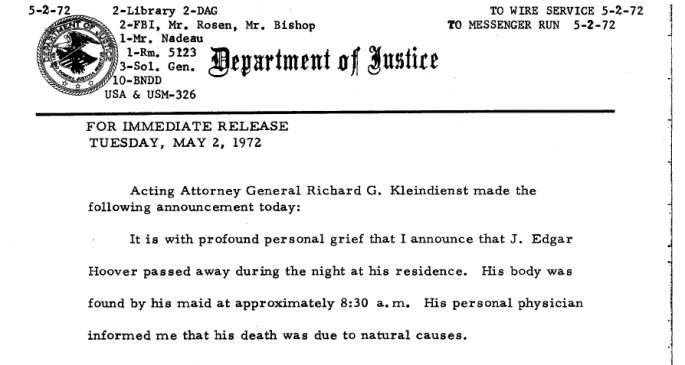On October 26, 1881, a 30-second gunfight became the stuff of legend. Today marks the 130th anniversary of the shoot-out at the O.K. Corral, and to commemorate the occasion, Katie Beaver, a summer intern in textual processing, wrote the following post. One of the most well-known stories of the “Wild West” comes from Tombstone, Arizona: … Continue reading How the West was Won: Marshal Dake, the Earp Brothers, and the Tombstone Shootout
Category: Crime, Justice, and Intelligence
Criminals, Outlaws, Law Enforcement, Department of Justice (DOJ), Federal Bureau of Investigation (FBI), etc.
Legends in the “Twin Territories”
This post was written by Katy Berube, who was a summer intern in textual processing. When Deputy Marshal Bass Reeves began to sing softly to himself, people who knew him ran for cover. An uncommon reaction, you might think, but from many accounts it was best to steer clear of a singing Bass Reeves as … Continue reading Legends in the “Twin Territories”
The U.S. Marshal Service and The Supreme Court
This post was written by Katie Beaver, a student intern working with civilian records. It is a follow-up to A few good lawmen. The American South was a particularly tumultuous area after the Civil War and during the occupation of the U.S. Army. Slaves became freedmen and gained the rights of citizenship per the Constitution. … Continue reading The U.S. Marshal Service and The Supreme Court
Deputy Marshal v. Deputy Marshal
This post was written by Katy Berube, a student intern working in civilian processing. It is a follow-up to the post A few good lawmen. As guns unloaded into British subject and cattle investor, John H. Tunstall, in the dusty, remote hills of the New Mexico Territory on February 18, 1878, the grab for power … Continue reading Deputy Marshal v. Deputy Marshal
A few good lawmen
Today's post is written by Denise Henderson. A few months ago, I was asked to locate a record about Pat Garrett, the famous sheriff who killed Billy the Kid in 1881 when cowboys and cattle thieves made the West wild and dangerous and a place in serious need of law enforcement. Understanding the index to, … Continue reading A few good lawmen
After 200 years, a glimpse into The Art of Secret Writing
Today's post is written by James Rush, a supervisory archivist in the textual processing unit at Archives II. On June 8, 2011, the National Security Agency announced that it had declassified and released to the National Archives and Records Administration over 50,000 pages of historic records relating to cryptology and the history of intelligence gathering. … Continue reading After 200 years, a glimpse into The Art of Secret Writing
19th Century Capital Punishment
Today’s post is written by Ashby Crowder, a processing archivist who works primarily with civilian records. During a stack inventory project, I came across a small series of records related to the practice of capital punishment in the United States in the late nineteenth century. The series is entitled Governors' Replies to a Circular on … Continue reading 19th Century Capital Punishment
FOIA: The Other “F” Word (Accessing FBI Records)
Today’s post is written by Dawn Sherman-Fells, a processing archivist who works with civilian textual records. Are you one of the many who believe that FOIA is truly a “four letter word”? Understanding the Freedom of Information Act can be daunting, frustrating -- intimidating, even. Here I will share a few tips that will hopefully facilitate a better understanding … Continue reading FOIA: The Other “F” Word (Accessing FBI Records)
The Octopus
Today’s post is written by Alfie Paul, a processing archivist who works with civilian textual records. On an August day in 1991, the body of free-lance reporter Danny Casolaro was found dead in a Martinsburg, West Virginia motel bathtub by two maids. Ruled a suicide, Casolaro’s death was just a small piece of a larger … Continue reading The Octopus
The gangster, the bank robber, the baby face, and a G-Man
By Denise Henderson Yesterday, I posted about Department of Justice press releases. Today, I’d like to share a few of my favorites! One early press release, dated November 6, 1933, details the establishment of a federal penitentiary on Alcatraz Island, which according to the release, “is a necessary part of the Government’s campaign against predatory … Continue reading The gangster, the bank robber, the baby face, and a G-Man







